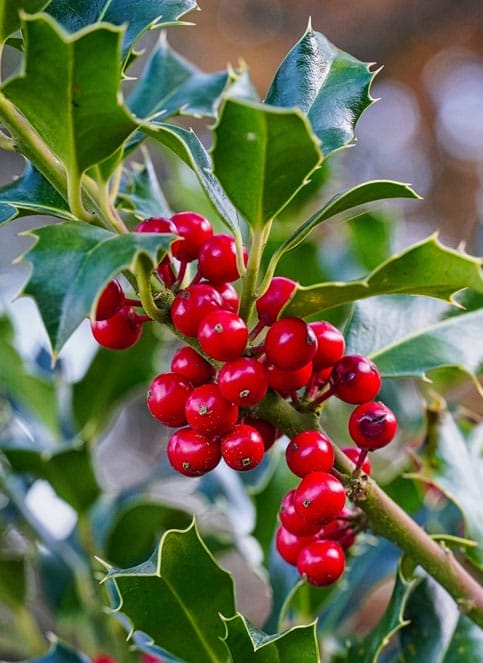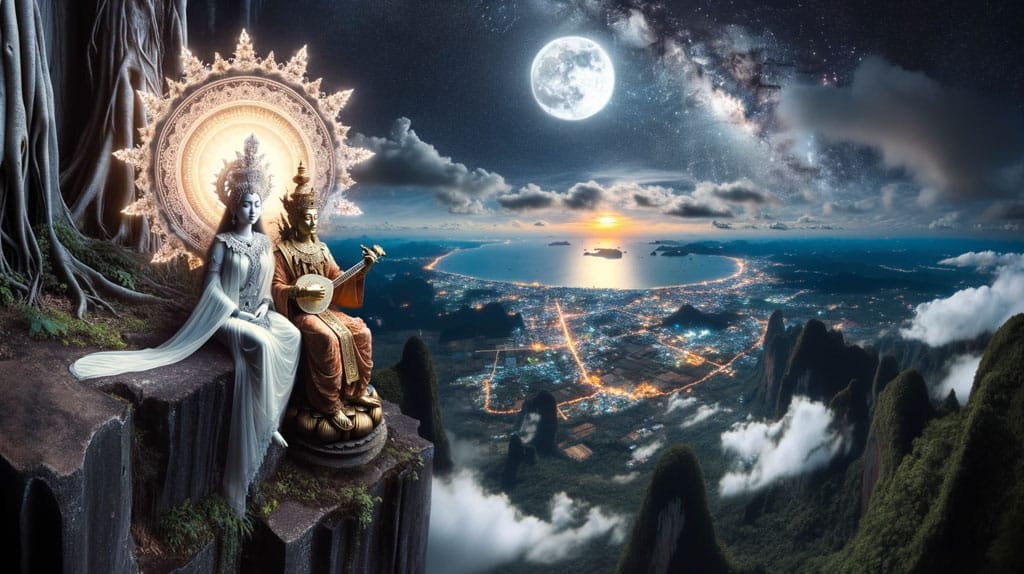Explore Pagan Christmas Traditions: Uncover Hidden Roots
The holiday season is a time of celebration and joy, but have you ever stopped to wonder about the origins of your favorite Christmas traditions? From the exchange of gifts to the lighting of candles, many holiday customs have deep roots in ancient pagan traditions.

We’ll delve into the fascinating world of Pagan Christmas traditions and uncover their hidden roots. You’ll discover the profound influence these customs have on our modern holiday seasons, from the Winter Solstice to Yule traditions.
Key Takeaways:
- Pagan holiday traditions have a rich history dating back thousands of years.
- The Winter Solstice holds great significance in Paganism and marks the turning point of the year.
- Yule traditions, including the use of evergreens and the burning of Yule logs, celebrate the cycle of life, death, and rebirth.
- Mistletoe and Holly have deep roots in pagan lore and traditions and continue to be incorporated into modern holiday celebrations.
- Pagan Christmas traditions often reflect a deep reverence for nature and the natural world, with eco-friendly practices and nature-focused rituals.
Understanding Paganism: Origins and Beliefs
Before exploring specific pagan Christmas traditions, it’s important to understand the origins and beliefs of Paganism. As you may know, Paganism refers to a group of diverse polytheistic religions that pre-date Christianity.
Paganism has had a significant influence on Christmas, with many non-Christian holiday traditions becoming intertwined with modern celebrations. The Christmas tree, for example, has its roots in ancient pagan customs that involved decorating evergreen trees as symbols of life and renewal.
At the heart of Paganism is a deep reverence for nature and the natural world. Many pagans believe in multiple deities, with an emphasis on the cycles of life, death, and rebirth. These beliefs continue to shape modern pagan holiday practices and celebrations.
The Winter Solstice: Celebrating the Return of Light
You may know the winter solstice as the shortest day and longest night of the year, but in Paganism, this day holds special significance. The winter solstice marks the turning point of the year when the days begin to get longer and the sun starts to regain its strength. Pagan winter solstice celebrations, also known as Yule traditions, are a way to honor this momentous occasion and celebrate the return of light.
The winter solstice has been celebrated by various cultures throughout history, but in Paganism, it represents the rebirth of the sun and the coming of a new cycle. Pagan Yule traditions often involve the lighting of fires or candles as a symbol of the returning light. Many Pagans also decorate their homes with evergreens, holly, and mistletoe to honor the enduring strength of nature even in the darkest of times.
Pagan winter solstice celebrations often involve feasting and gift-giving, with traditional foods such as spiced cider, roasted meats, and warm bread. Pagans also engage in rituals and ceremonies to welcome the return of the sun and to set intentions for the coming year. For example, some Pagans may participate in a ritual bath to cleanse and renew their spirits, while others may hold a candlelight vigil to symbolize the hope and resilience that comes with the return of light.
The winter solstice is a time to reflect on the cycle of life and death, and the importance of both light and darkness in the natural world. Pagan Yule traditions emphasize the interconnectedness of all things and encourage us to find balance in our lives. By celebrating the return of light, Pagans hope to inspire hope, renewal, and growth in the coming year.
If you’re interested in exploring Pagan winter solstice celebrations, consider attending a local gathering or participating in your own ritual at home. Regardless of your beliefs, the winter solstice is a powerful reminder of the enduring strength of nature and the importance of finding balance in our lives.
Yule Logs and Evergreen Decorations: Symbols of Renewal
Yule logs and evergreen decorations are iconic symbols of pagan Christmas traditions. The Yule log has its origins in the ancient Norse tradition of burning a large log to symbolize the return of light and warmth during the winter solstice.

Decorating with evergreens has been a pagan tradition for centuries. The evergreen trees and plants represent the eternal cycle of life, death, and rebirth. The custom of bringing evergreen branches into the home during the winter months is a reminder that life endures even in the darkest of times.
In modern pagan Yule traditions, burning a Yule log is a way to honor the turning point of the year and symbolize the release of the old and the welcoming of the new. The ashes from the Yule log are believed to have magical properties, and some use them in spells and rituals throughout the year.
Similarly, evergreen decorations are still a popular way to celebrate the season of renewal. From wreaths and garlands to Christmas trees and boughs of holly, the presence of evergreens in the home evoke feelings of warmth, comfort, and continuity.
These ancient pagan customs continue to influence modern Christmas rituals, reminding us of the unbroken cycle of life and the power of nature to renew and sustain us.
Mistletoe and Holly: Sacred Plants of Pagan Lore
As you explore the ancient pagan customs associated with Christmas traditions, mistletoe, and holly are two plants that you’ll discover have deep roots in pagan lore.

Mistletoe, with its distinctive white berries, was considered a sacred plant in Celtic and Norse traditions. It was believed to have special healing powers and was often used in spiritual rituals. During the winter solstice, mistletoe was hung in doorways to protect against evil spirits and promote fertility.
Holly, with its sharp-toothed leaves and bright red berries, was also revered by the Celts, who associated it with the god of the winter solstice. The Romans also used holly in their Saturnalia celebrations, where it symbolized the rebirth of the sun.
Today, mistletoe and holly continue to be incorporated into modern holiday traditions, often in the form of decorations or as part of Christmas rituals. The custom of kissing under the mistletoe, for example, is said to have originated from pagan practices where couples would kiss under the plant to ensure fertility and good luck.
By understanding the sacred symbolism behind mistletoe and holly, you can gain a deeper appreciation for these plants and their role in ancient pagan traditions.
Feast and Merriment: Pagan Celebrations of Abundance
As the winter season approaches, the focus shifts to celebration and feasting. During pagan times, the end of the year was a time to honor the abundance of the harvest and give thanks for the blessings of the season.
Feasting was an important part of pagan holiday traditions, with elaborate meals and festive gatherings bringing communities together. The sharing of food and drink symbolized the spirit of generosity and gratitude. In some Pagan cultures, it was believed that sharing food with others honored the gods, promoting abundance and good fortune for the new year.
Pagan customs also emphasized the idea of balance and the cycle of life, death, and rebirth. During the winter solstice, the darkest time of the year, fire was seen as a powerful symbol of renewal. Lighting candles and fires represented the return of the sun and the promise of new life. In fact, the tradition of burning a Yule log, often made from a piece of wood saved from the previous year’s log, was said to bring protection and good luck for the coming year.
Today, the modern Christmas Calendar continues to embrace the spirit of feasting and merriment. Celebrations often include traditional meals and drinks, such as mulled wine and spiced cider. Rituals may involve lighting candles or fires, signifying the return of light and the promise of spring.
The emphasis on abundance and gratitude in pagan traditions can also inspire individuals and communities to give back during the holiday season. Volunteering at food banks or donating to local charities is a way to honor the spirit of generosity and kindness that is central to pagan holiday traditions.
By embracing the values of abundance, balance, and community, modern pagan holiday practices offer a unique perspective on the meaning of the winter season. Whether through feasting, lighting candles, or giving back, these ancient pagan customs continue to influence our understanding of the season and our connection to each other and the natural world.
The Goddess and the Sun God: Deities in Pagan Traditions
As we explore pagan holiday traditions, it’s important to understand the prominent role that deities play in these customs. The Goddess and the Sun God are two of the most revered deities in pagan traditions, particularly during the winter season.
The Goddess represents the earth, the moon, and the feminine energy of nature. During the winter solstice, pagans celebrate her strength and fortitude as she gives birth to the Sun God, who represents the new year and the return of light. Together, the Goddess and the Sun God symbolize the cycle of life, death, and rebirth that is so integral to pagan beliefs.
Ancient pagan customs associated with the worship of these deities were often centered around the winter solstice. Pagan communities would gather around large bonfires to honor the power of the Sun God and to celebrate the return of light. Meanwhile, rituals devoted to the Goddess might involve decorating evergreen trees or creating wreaths of holly and mistletoe.

Today, many modern Pagans continue to honor the Goddess and the Sun God during the winter season. For example, some may light candles to symbolize the return of light, or perform rituals to connect with the energy of nature. No matter how these deities are celebrated, they remain a central part of pagan holiday traditions and continue to inspire reverence and awe.
By understanding the role of deities in pagan Christmas traditions, we gain a deeper appreciation for the spiritual significance of these customs. Whether you’re a practicing Pagan or simply interested in learning more about these ancient beliefs, exploring the worship of the Goddess and the Sun God is a fascinating journey into the heart of pagan holiday traditions and ancient pagan customs.
Incorporating Pagan Traditions into Modern Celebrations
Are you curious about incorporating pagan Christmas rituals into your modern holiday practices? You’re not alone! Many people today find meaning in the ancient customs of Paganism and infuse them into their celebrations. Modern pagan holiday practices draw inspiration from the rich history of pagan traditions and offer a unique way to connect with the spiritual essence of the holiday season.

One way to incorporate pagan Christmas rituals is by hosting a solstice ceremony. This can involve lighting candles or a bonfire to symbolize the return of light and warmth during the darkest days of winter. Another way to honor pagan Yule traditions is by decorating your home with evergreens, such as pine, spruce, and holly. These evergreens represent the eternal cycle of life, death, and rebirth.
Another popular pagan tradition is the use of mistletoe. This sacred plant was believed to have healing properties and was often used to ward off evil spirits. Today, it’s a popular decoration during the holiday season, with couples sharing kisses under the mistletoe.
Candlelight rituals are also a way to infuse your celebrations with the spirit of ancient pagan customs. Light candles to represent the warmth and light of the sun, and offer gratitude for the blessings of the past year. This can be a beautiful and meditative way to connect with the spiritual essence of the season.
By incorporating pagan Christmas rituals into your modern holiday practices, you can create a deeper connection with the ancient traditions that have influenced our modern celebrations. Whether it’s hosting a solstice ceremony, decorating with evergreens, or using mistletoe and candles, there are many ways to infuse your celebrations with the spirit of Paganism.
Reverence for Nature: Pagan Values in the Modern World
One of the enduring values of pagan holiday traditions is a reverence for nature and the natural world. For pagans, the winter solstice marks the turning point of the year and the rebirth of the sun. This emphasis on the cyclical nature of life and the changing of the seasons has led many modern pagans to embrace eco-friendly practices and a renewed appreciation for the Earth.
Modern pagan holiday practices often reflect this connection to nature through nature-focused rituals and observances. Many pagans celebrate the winter solstice with outdoor gatherings or perform traditional ceremonies such as burning a Yule log or lighting candles to represent the return of the sun.
For those who incorporate pagan holiday traditions into their modern celebrations, this reverence for nature can be a powerful reminder of the need to protect and honor the environment. As concerns about climate change and sustainability continue to grow, pagan values of respect for the Earth offer a vital perspective on our relationship with the natural world.
By embracing the values inherent in pagan holiday traditions, we can also deepen our connection to the world around us and cultivate a sense of gratitude for all that nature provides. Whether it’s through eco-friendly practices or simply taking time to appreciate the beauty of the natural world, incorporating pagan values into our holiday celebrations can enrich our lives and inspire us to make a positive impact on the planet.
FAQ
Q: What are pagan Christmas traditions?
A: Pagan Christmas traditions refer to customs and practices that have their roots in ancient pagan cultures and were later incorporated into the celebration of Christmas. These traditions often revolve around the winter solstice, the worship of nature deities, and the celebration of abundance.
Q: How do pagan traditions influence Christmas?
A: Pagan traditions have had a significant influence on Christmas. Many customs, such as the decoration of evergreen trees, the burning of Yule logs, and the exchange of gifts, can be traced back to pagan practices. These traditions were later adopted and adapted by Christian communities during the spread of Christianity.
Q: What are some common pagan Christmas rituals?
A: Common pagan Christmas rituals include lighting candles or bonfires to symbolize the return of light, performing ceremonies to honor nature spirits, decorating homes with evergreen branches, and sharing feasts with loved ones. These rituals vary across different pagan traditions and communities.
Q: Can I incorporate pagan traditions into my modern Christmas celebrations?
A: Absolutely! Many individuals and communities today incorporate pagan traditions into their modern Christmas celebrations. You can celebrate the winter solstice, decorate with evergreens, perform rituals honoring nature, or simply learn more about the pagan origins of Christmas customs. It’s a way to connect with ancient traditions and add depth to your holiday celebrations.
Q: Are pagan Christmas traditions only for pagans?
A: No, pagan Christmas traditions are not limited to pagans. These customs have become a part of our shared cultural heritage and can be celebrated by anyone interested in exploring their origins and meaning. You don’t have to identify as pagan to appreciate the beauty and significance of these ancient traditions.




